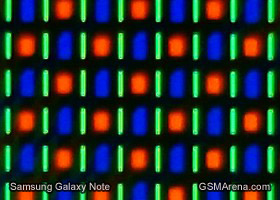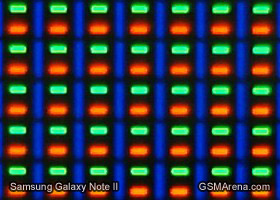Love that video thanks. Loving the Note 2 more and more.
Some excellent features they've added there like the hover over pen and screen recorder, and suped up version of paper camera etc.
It is huge though!
Love that video thanks. Loving the Note 2 more and more.
What awesome things will you be doing with that extra resolution?
Interesting! Does your rumour source say who it's made by?
Surf the internet as easily as i can on a desktop without having to sqint, or zoom around like a spanner
Surf the internet as easily as i can on a desktop without having to sqint, or zoom around like a spanner
 you're just blooowing a big bubble out of it.
you're just blooowing a big bubble out of it.But an increased resolution will just make everything smaller!
Although people have got me worrying about the screen now


he pixels of the Note II have one tall Blue sub-pixel on the left and smaller Green and Red pixels stacked one on top of the other. It's an odd arrangement, but it has three subpixels per pixel. The reason for the different Blue pixel is that Blue AMOLEDs typically have a shorter life and making them bigger balances things out. Also, the Blue pixel doesn't shine as brightly, which also improves its life, but doesn't affect color balance (because it's bigger).
One cool addition to the display settings is that even with Automatic brightness turned on, the brightness slider remains active. This allows you to fine-tune the brightness, but still have it adjust automatically to the environment.
Not sure if that's an issue anymore, the S2 maximum brightness was more then enough for me and i usually have it at about 60%. Any more brightness avalible to me would be wasted
Wahey! Finally....just like on the iPhone!!
Also 478 cd/m2 max brightness - awesome! SGS3 is 330.
 much prefer how it works on my SGS2.
much prefer how it works on my SGS2.Does anybody know whether the new Note will take a full size SIM or a micro like the S3?
Does anybody know whether the new Note will take a full size SIM or a micro like the S3?


Soo 3 subpixels - which makes it a halfway RGB screen?
wiki said:Additionally, as the OLED material used to produce blue light degrades significantly more rapidly than the materials that produce other colors, blue light output will decrease relative to the other colors of light. This variation in the differential color output will change the color balance of the display and is much more noticeable than a decrease in overall luminance.[62] This can be partially avoided by adjusting colour balance but this may require advanced control circuits and interaction with the user, which is unacceptable for some users. In order to delay the problem, manufacturers bias the colour balance towards blue so that the display initially has an artificially blue tint, leading to complaints of artificial-looking, over-saturated colors. More commonly, though, manufacturers optimize the size of the R, G and B subpixels to reduce the current density through the subpixel in order to equalize lifetime at full luminance. For example, a blue subpixel may be 100% larger than the green subpixel. The red subpixel may be 10% smaller than the green.
No "halfway" about it - if it's three sub-pixels per pixel (with one red, one blue and one green), then it isn't PenTile.

